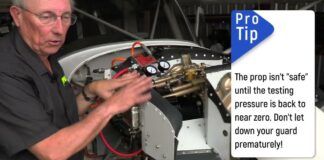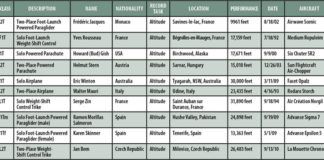Over the years, I have accumulated a bit of wisdom concerning the design of airplanes. Much of this comes from having made mistakes myself and from observing, or being called upon to fix, the mistakes of others. In the process, I have formulated a few rules to guide the thinking of designers. While they are primarily intended for airplane designers, they are likely applicable to almost any engineering endeavor. This month, I’ll share these rules with you.
1. Function over features.
Bear in mind that an airplane is a tool to do a job. The designer’s task is to produce a machine that performs the customer’s mission well. The mission can be as simple as “get airborne and fly around the patch on a sunny Saturday morning,” or it can be a difficult set of range, payload and speed requirements.
A common trap is fixating on specific features (such as winglets or a specific engine) too early and incorporating these apparently desirable features into the design. These features may or may not be appropriate for the task the airplane must perform, and focusing on them, rather than the mission performance, may not lead to a very good final product. Every aspect of a proposed design should be formulated and evaluated on the basis of how it helps the airplane perform the mission.
2. A well-conceived design beats a bunch of fixes flying in formation.
A good design is created early in the process. If the designer makes the right choices about configuration, size, structural load paths, engine, etc., the airplane will perform its mission effectively. The ability to fix problems decreases rapidly as the design matures. Any problem that survives into the flight-test phase of the project will likely be difficult and expensive to fix well because it will require changes to already tooled or already built components. If this happens, the program will resort to a variety of band-aids to fix the problem well enough to make the airplane fly acceptably. These fixes almost always hurt performance, and developing them can be costly and time consuming.
3. Details count.
While good detail design cannot always save a poorly conceived machine, poor detail design can always ruin an otherwise good concept. Relatively small details can cause (or save) a lot of drag and have a large effect on performance. Likewise, small configuration details, such as a few degrees of wing twist or the shape of a control surface, can be the difference between an airplane with excellent flying qualities and one that is difficult to control.
4. Never show a customer a configuration you don’t want to build.
Remember that when you show a customer or a potential investor a drawing or a CGI video of your proposed airplane, they will see it as a workable design. If they fall in love with it, it will then become your task to build it and make it fly right. If what you showed them was inspired more by styling or technological fads than engineering, you might have a serious problem.
A second way of falling into this trap is to offer a customer a choice of concepts where at least one of the options is a straw man placed in the mix to make it look like there are more workable choices than there really are. One thing is painfully certain: If you offer your customer a choice of several concepts and among them is a hastily conceived straw man that the customer is supposed to reject in favor of the better concept that you know will work well, he’ll fall in love with that misbegotten straw man. I have personally dealt with this one in my professional life (although I did not make the mistake, I was called upon to make the straw-man airplane work), and I know of at least one program where the airplane got built and was a failure in the marketplace.
5. Today’s “negligible” problem is the seed of tomorrow’s disaster.
If you look at the history of failed programs and accidents, you will find there is almost always some warning of the fatal problem well before it becomes serious. Wind-tunnel data usually give some indication of future flying-qualities problems. Things that crack or break on prototypes are warnings of a structural problem. Systems rarely fail suddenly.
Unfortunately, it is common to ignore small problems or put them down to one-time anomalies. The pressures of cost, schedule and larger problems make it tempting to declare something negligible and move on. Too often, that seemingly small problem turns into a big, expensive or dangerous problem later on, when it is difficult to fix.
6. You can’t fix it later.
On a similar note, it is quite tempting to put off fixing a problem and hope it will just go away. Unfortunately, it never does, and you will have to deal with it eventually.
7. You can’t fix it in software either.
Many modern airplanes use full-authority digital flight-control systems. The pilot’s controls tell the computer what he wants the airplane to do, and the computer commands the control surfaces. This system makes many things possible because the flight-control computer can also be programmed to use the controls to augment the stability
of the airplane and compensate for other characteristics of the basic airframe. Because this type of control system is so powerful, it is tempting to believe that any aerodynamic issue with the airframe can be solved by proper programming of the flight-control software. Unfortunately, this is not true. The computer can command the surfaces faster than a pilot and mix the control inputs in more complex ways than the pilot, but in the end, its ability to control the airplane is limited by the aerodynamic effectiveness of the control surfaces, the speed of the control actuators and the amount of control power needed to control the airplane.
In many cases, even the computer’s speed and sophistication is not enough to keep an ill-handling airframe under control. If the designers chose to accept unpleasant behavior in the basic airframe based on the belief that they could “fix it in software,” the project is in trouble. There is still no substitute for an airframe with well-behaved aerodynamics.
8. Mother Nature doesn’t read the brochure.
Your brochure, or your design notebook, can say anything you want it to. What you are able to convince other people to believe about your airplane does not change the real characteristics of the airplane one bit. Don’t fall into the trap of concealing information and exaggerating claims to make the airplane look better. At best, it’s fraud, and at worst, if you start believing your own propaganda, it’s dangerous.
9. The Universe doesn’t care: Physics doesn’t change, no matter how much you want it to.
There is no place for wishful thinking in airplane design or operation. What the airplane will do is determined by physics, not hope. A well-designed, well-maintained airplane will fly safely and well. A poorly conceived or poorly maintained airplane will not be sustained by the wish that things were different.

![]()
Barnaby Wainfan is a principal aerodynamics engineer for Northrop Grumman’s Advanced Design organization. A private pilot with single engine and glider ratings, Barnaby has been involved in the design of unconventional airplanes including canards, joined wings, flying wings and some too strange to fall into any known category.













